
Inhabiting their sixteenth century world — dressing as they did
The late Dame Hilary Mantel advised that those who a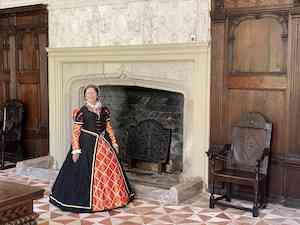 spire to write historical fiction should aim to inhabit the era in which their writing is set.
spire to write historical fiction should aim to inhabit the era in which their writing is set.
“Live in that world,” she said, “and this magic day comes and it becomes solid and real. If you can get your five senses working for you, you are home and eventually your dreams will move to your chosen period as well.”
I’ve taken that advice on board and I now spend much more time in the sixteenth century than the twenty-first.
I visit wonderful old buildings.
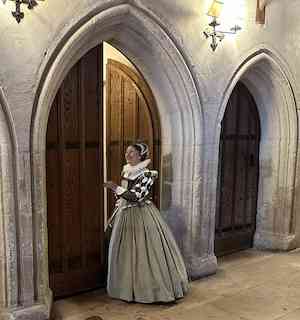
I taste Tudor food flavoured with surprisingly tangy spices. I listen to sixteenth century music, be it a lute in the great hall of timber framed mansion or wonderful voices lifted in song in a magnificent space like Exeter Cathedral.
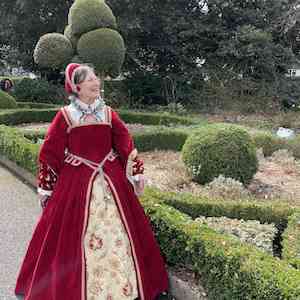
I often walk in Elizabethan knot gardens and linger beside their low clipped hedges to fill my lungs with the scent of herbs and flowers like roses, gilly flowers and lavender.
In short, I take every opportunity to experience the sights, smells, tastes and sounds of their world.
Dressing as they did adds the fifth sense — touch. This is the part of my writers research that really puts me in touch with the women I write about — the forgotten women who stood behind their menfolk, who played their part in Devon’s and England’s story, but have left the lightest of footprints on the historical record.
Dressed as the Lady Katheirne, I can actually feel the soft touch of linen on my skin and know exactly what a high status sixteenth century woman felt when wearing a smock beneath layers of skirts and farthingale hoops while constrained within boned bodies. I can run my hand over fine silks and velvets, feel the texture of the cloth they wore. I can practice the exact tilt of the head needed when wearing a starched ruff. I can feel the fit of a headdress well anchored to hair braided Tudor style. I can move lightly in a dance in my square toed shoes.
“You can’t understand someone until you’ve walked a mile in their shoes.”
The person who first uttered this American saying is lost to history. By visiting places my characters knew in sixteenth century clothing I can walk in their shoes.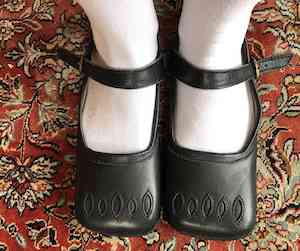
The experience of wearing those clothes opens a window on women’s lives which I doubt can be achieved in any other way. As Historian Susannah Lipscombe wrote in an article for History Today some time ago
“Dressing in historical clothes can reveal things about the past that no book can.”
For this to work it’s important that the outfits I create are as close as possible to those they wore. Over the years I’ve set out to learn more about the way clothing was constructed and increasingly I use materials and techniques used by Tudor and Elizabethan tailors.
Sometimes I refer to myself as a sixteenth century seamstress, though that’s a bit of a contradiction in terms as most of those who made the clothes in those times were actually men. Tailors who clothed the wealthy had successful businesses employing journeymen tailors and apprentices while clothing for the less well off was produced on a smaller scale by local tailors — perhaps a bit like those you might still find sitting on street corners today in countries like India. Needlework and fine embroidery were skills taught to all higher status girls from a very young age and they would create and embellish linen shifts, shirts, partlets and cuffs, sweet bags or even book covers. Working women were more likely to spend their time mending, making alterations to extend the life of garments such as the unenviable task of replacing worn and soiled underarm gussets, or spinning woollen yarn and knitting
As I’ve researched the clothing of the time I’ve also discovered a wealth of detail about life for both rich and poor; linen and laundry, wool and silk, dyes, fashion trends, merchants and guilds, who wore what and the sumptuary laws which leads me into politics, international trade and even piracy. All of this helps me to build a picture of the social and economic structures of Tudor Devon and through that I find glimpses of the day to day life of my characters.
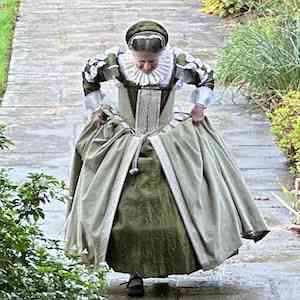
Wearing their clothes really brings the practicalities of life for a wealthy sixteenth century woman into focus. For example, it really is quite impossible to negotiate a narrow spiral staircase or any steps swiftly while dressed in full fig farthingale and all. Two hands are often needed to lift full skirts to avoid tripping, so carrying a bag or any other objects is tricky.
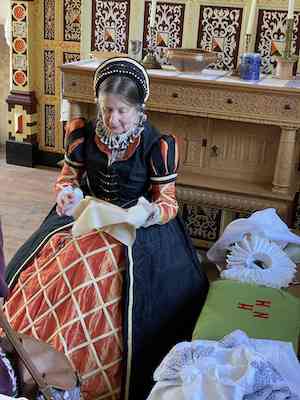
Sitting down elegantly while wearing a farthingale requires a careful technique. (Fortunately they used chairs less that we do now; sitting decorously on a stool cushions is somewhat easier.)
Flat square-toed shoes are incredibly comfortable, but while you might dance a little it is not easy to run in them.
I’ve learned that linen is the most comfortable fabric in the world — light and soft, hugely absorbent (its said that linen can absorbent twenty percent of its weight before it feels wet to the touch). It withstands years of wash and wear and becomes even softer over time. Because the farthingale and bum roll support the weight of the skirts they do not cling to my legs and are not over-hot in summer. Boning and busks (pieces of wood, bone or ivory inserted at the front of the bodice to give a flat look) are much more agreeable to wear than you might think. Oh, and I now know the answer to the question my school groups always ask “How did they go to the toilet?”. (I’m afraid I never divulge exactly how far I take authenticity!)
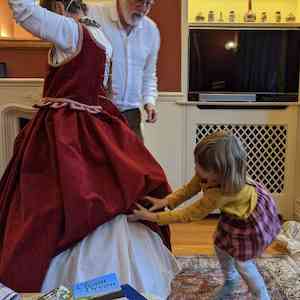
It is not possible to dress yourself as a sixteenth century lady — at least one lady’s maid is required. That has made me realise how little privacy Tudor gentry and noble families enjoyed. The time of communal living in a great hall had passed and In wealthy houses private chambers were available. But lives were still lived in the most intimate detail in full view of a host of serving people. Maids often slept on a truckle bed in the bedchamber and the laundry maid was first to know a women’s most private secrets. The concept of privacy as we know it would probably seem quite strange.
I doubt very much if the fashionable ensembles we see in grand portraits were worn day to day. Rather, I suspect they were kept for important social occasions, visits to court or entertaining influential neighbours. I’m sure a gentlewoman’s wardrobe must have included lots of more practical clothes similar to those I don to become Bessie the serving maid, albeit in more costly fabics.
There’s a huge contrast between my lady’s clothes and those of her servant. Wearing the simple kirtle, woollen cap or linen coif, partlet and apron of a working woman, feeling the rough texture of coarsely woven wool, the weight of heavy skirts, is a completely different experience.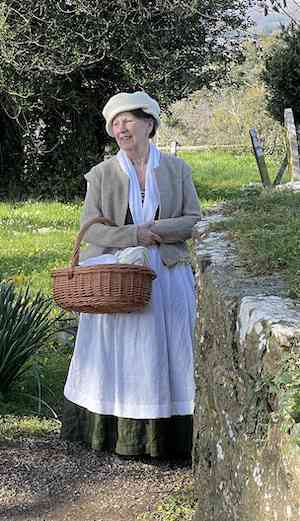
By far the most interesting aspect is the effect the clothes have on me and how different my movement becomes depending which set of clothing I’m wearing.
As soon as I don the Lady Katherine’s garb I change. I don’t think about it. It simply happens. I hold myself with pride and assurance, head high, graceful and elegant. I instantly feel and become a different person. As the Lady Katherine I glide, I sweep, I float, I drift, I promenade, I progress. Occasionally I flounce.
But when I put on Bessie the serving maid’s clothes I feel comfortable, busy, grounded and ready to tackle any job. As Bessie I bustle, I scurry, I dart, I tramp. My arms move much more than when I’m dressed as my lady. Occasionally I trudge or I amble.
I suppose, one might say, “Clothes maketh the woman”.
(Check out the Reel on my instgram and Facebook page to see this in action.)
The style of dress may have had a similar effect on the women of the past. High born women must have felt empowered by their clothes just as I do when dressed as Katherine. Women born into wealthy gentry families in what was a predominantly patriarchal society might well have been glad of the elegance and authority those clothes confer. Although they had little or no choice when it came to marriage, these women were by no means downtrodden bystanders. They were required to represent to the world the status, nobility and gentility of their family; they were responsible for managing large households, overseeing the work of many servants, keeping the household well supplied with food through good times and bad; providing medicines to keep everyone in good health. They were also responsible for the early years education of their children, for arranging advantageous marriages and they often stood in for their husbands while they were away. They were educated for the wide range of accomplishments they would need to fulfil all those roles successfully. They were not without their own power, as Barbara J. Harris points out in her fascinating book English Aristocratic Women, 1450 to 1550. “Through marriage, they entered into lifetime careers that gave them considerable power, even authority over their families, servants. and local regions…”
I find conveying the contradictions of their world, giving these women appropriate agency while respecting their acceptance of male dominance, one of the most difficult parts of writing historical fiction for a modern day audience. Wearing their clothes puts me in touch with them in a way not possible through other means. It helps me experience and understand their world a little better, so that I can take readers there through my writing.
And yes, I do sometimes dream in that time.
.
The Historian Embodied by Susannah Lipscombe History Today Volume 71 Issue 6 June 2021
English Aristocratic Women 1450-1550 by Barbara J Harris
Patterns for outfits shown here based on those in The Tudor Tailor, The Tudor Child and the Typical Tudor available from https://www.tudortailor.com/
If you've enjoyed this article please share on social media using the links below
or you can send me comments via the contact form
